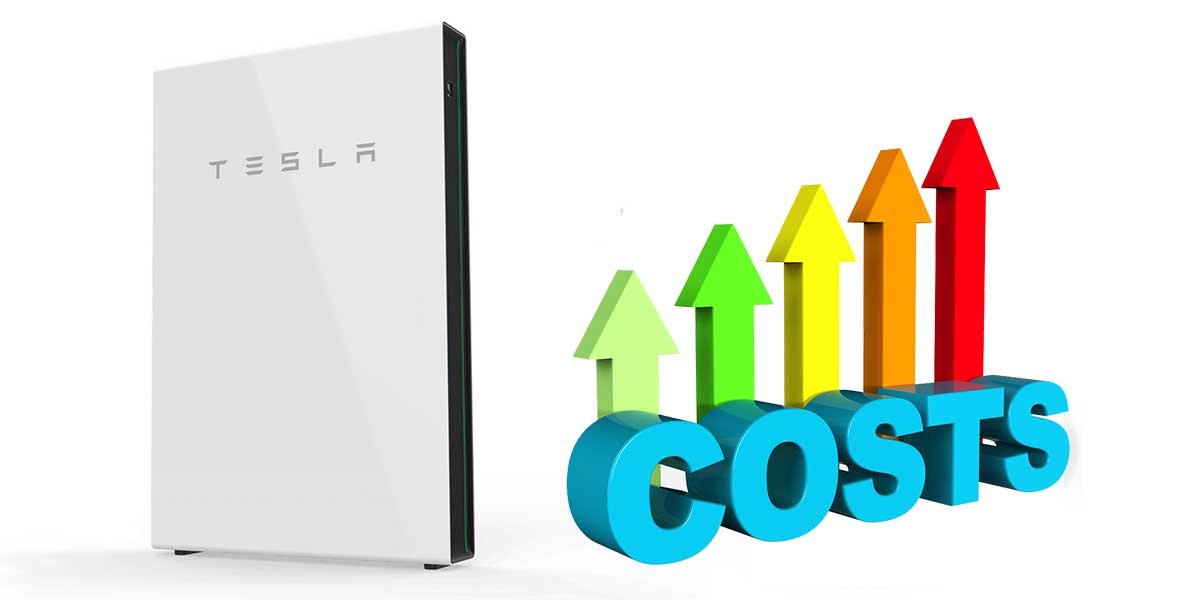
And you thought batteries were meant to be getting cheaper every year?
Sorry I’ve been slow in reporting this, but back in February Tesla raised the price of a Powerwall 2 in the United States by 400 Mickey Mouse dollars; an increase from US$5,500 to US$5,900. We’ve also copped it sweet here in Australia and the price has increased by $600 to $9,600 before installation. The only mitigating circumstance I can see is that all Tesla Powerwall 2 battery systems now come with full backup capability. It’s no longer an optional feature.
—
UPDATE October 2018: There’s been yet another Powerwall price increase since this article was published.
—–
This price increase is the exact opposite of what is supposed to be happening with the cost of home battery storage. It may be the result of Tesla being too optimistic about how cheap they could make them, or it might be because the company is desperate to raise money due to the huge delays and quality control issues they are having with the production of their Model 3 electric car.
I’m a great believer in compromise, so I don’t see why both reasons can’t be right. I’d even throw in a third reason of my own involving orders from the planet Mars if I thought anyone would fall for it.
A History Of Australian Powerwall 2 Prices
Prior to the Powerwall 2’s official launch, Elon Musk made some rather optimistic remarks about its price but I will ignore them. After all, when you get down to it, he is only the CEO of the 50th largest company in the United States and so can’t be expected to get things right. CEOs can’t be held responsible for their public statements. That would be positively un-American.
When the Powerwall 2 battery first launched this price appeared on Tesla’s Australian site:
That’s $8,000 Australian along with a claim that “Installation and supporting hardware starts at $1,450.” But it only took Tesla a couple of days to tell us they had made a mistake and that was the price without GST1. This is what they replaced it with:
The $8,000 price remained the same, so apparently they didn’t forget GST, but the cost for “Installation and supporting hardware” went up by $700 and started at $2,150 instead of $1,450. Tesla stuck with this price for a little over a year and now they have this on their Australian site:
This shows a cost increase of $600. They have improved the way the price is set out as it is now more clear there is an additional charge for “Supporting hardware”. But in my opinion, it’s still clearly in breach of Australian Consumer Law on displaying prices. One price including all components must be given, so the price of the Powerwall 2 is actually $9,600. That “Supporting hardware” is not an optional extra. Your Tesla Powerwall 2 won’t work without it so it has to be included in a single price.
Tesla’s Powerwall Installation Cost Claim
Tesla also says that, “Typical installation cost ranges from AUD$1,150 to AUD$2,900.” So using Tesla’s figures an installed Powerwall 2 will cost you somewhere from $10,750 to $12,500. Even the upper end of this does not leave much money for installers to make a living. So if anyone offers you an installed Powerwall 2 battery for less than this range you are either very very lucky or something strange is going on. For example, if it’s bundled in with a solar system then they’ve bumped up the solar power system’s cost so they can try to distract you with what appears to be a great price for a battery.
Australian Price = US Price
One thing I have always admired about Tesla is they don’t price discriminate when it comes to selling goods in Australia. While other electric car manufacturers have charged far more here than they have in their home market, Tesla has always sold their cars in Australia for pretty much what Americans pay after adjusting for tax. The same applies for their energy storage systems. Currently Americans have to pay US$6,600 for a Powerwall 2 battery. Using today’s exchange rate of 76 cents to the US dollar and adding our GST that would come to AUD$9,550. Almost the same as what we now have to pay here.
Why Up Instead Of Down?
The cost of batteries has been tumbling:
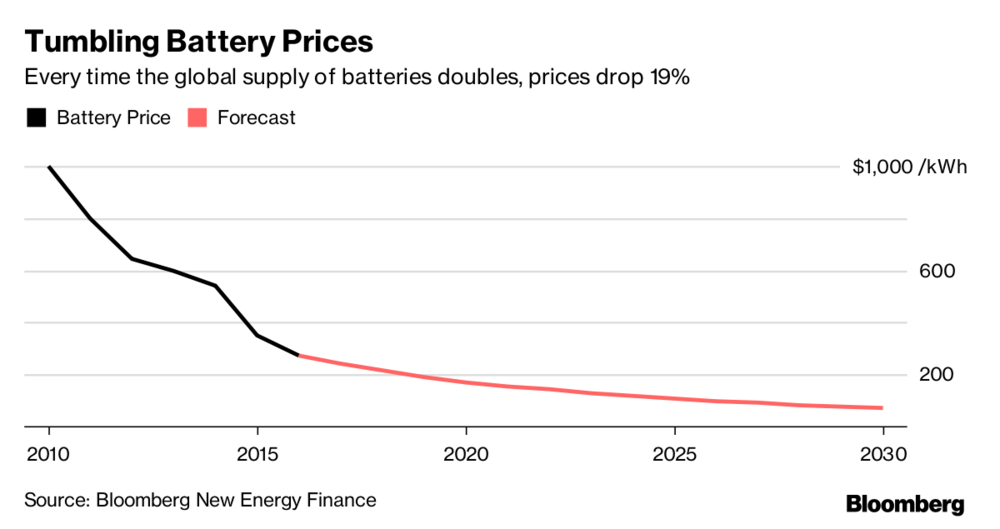
This graph is in American dollars. Except along the bottom where those are years not dollars. (Image Source: Bloomberg)
Tesla is doing considerably better than the graph above suggests and it is possible they are now only paying costs around $200 Australian per kilowatt-hour to make their battery packs. I suspect they are actually paying more than that, but not much more.
So if batteries are falling rapidly in price, why the hell is Tesla charging more for Powerwall 2 instead of less? My theory is it’s because they want more money. Oddly enough, this seems to be everyone else’s theory as well.
Some say Tesla may have underestimated how much it costs to make a Powerwall 2 while others say they need money because of hold ups with their Model 3 car production. I don’t know if the first idea is true but I do know the second one is. Here’s a whole site dedicated to showing how far behind Tesla is with their Model 3 and here’s a graph showing Tesla’s predictions for cars produced per week and how incredibly far off they are in reality:
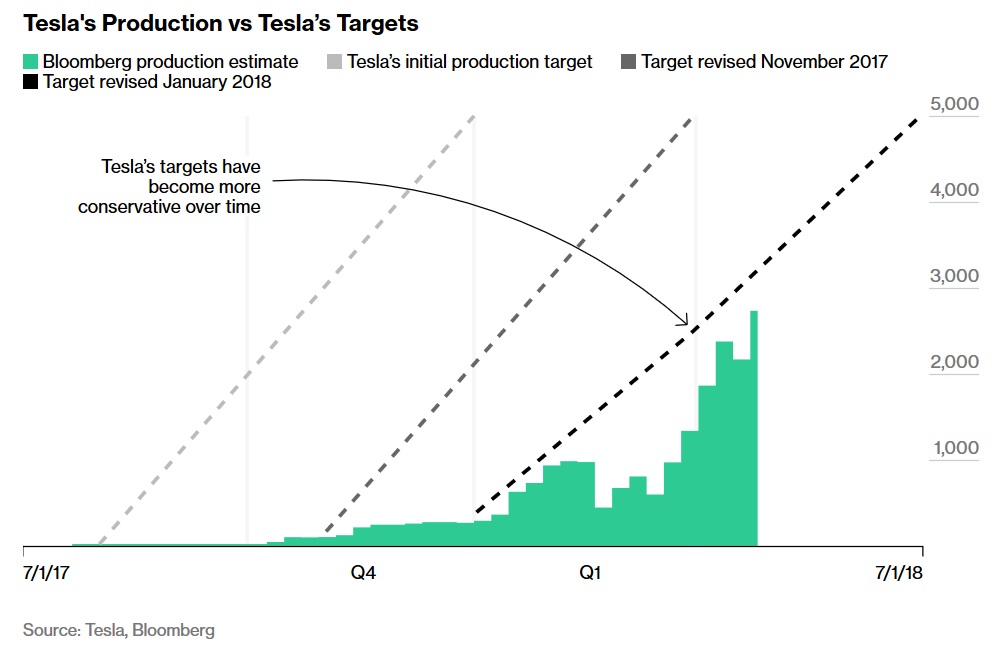
Who would have thought that creating a revolutionary new car and putting it into mass production without the 1-2 years of testing non-revolutionary cars get would cause problems? (Image Source: Bloomberg)
If Tesla had achieved their original target they’d now be selling around 10,000 Model 3 cars a week while raking in piles of money and keeping their investors happy. But currently their investors are not happy and if things don’t improve fast, eventually a group of them will say, “We’ll lend you the money you need to not go bust, but we want some changes so we can be confident our investment is safe.” These changes will probably involve kicking Elon Musk out as CEO and either exiling him to Mars or making him Vice President In Charge Of Crazy Shit To Distract The Press From Bad News. We know he’s good at that.
Because Elon Musk would rather go to Mars on his own terms, as Commander rather than cargo, he’s doing everything he can to raise money ranging from asking for a $66,000 deposit to reserve a new Tesla Roadster to raising the price of the Powerwall 2 battery.
Tesla Can Get Away With It — For Now
Tesla has no problem selling every Powerwall 2 it makes at the moment and the high demand for them means they may have been able to get away with increasing the price without losing sales. So in the short term Tesla’s management gets what they want — more money coming in and a slightly reduced chance of a major restructuring.
But in the longer run Tesla loses and the chance that home energy storage in the future will be dominated by an American company named after a Serbian founded by a South African grows smaller each day the price rise remains in effect. Tesla’s competitors are main beneficiaries of the price increase and they will expand their market share. This means Tesla will be in a less secure position in the future when it’s faced with high quality but low cost home battery systems coming out of China.
Footnotes
- Or VAT as they seemed to think it was called here. ↩

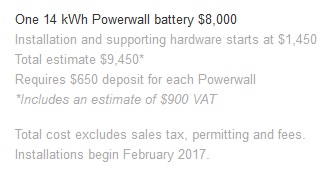
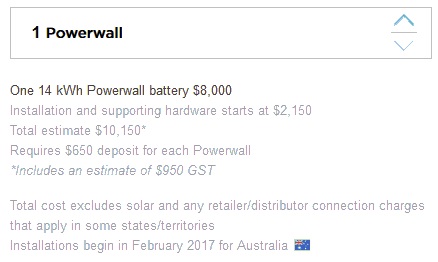
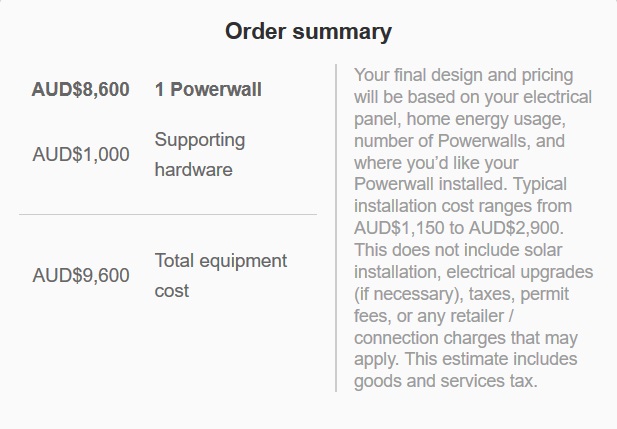
 RSS - Posts
RSS - Posts



Tesla is correct is breaking down the price into Powerwall + Supporting hardware, as you can have multiple Powerwalls with just one Gateway. If you want to add a second Powerwall is would be $8600 extra. Might need to remove your claim regarding consumer law.
You are incorrect in your analysis of cost of installion. Standalone Powerwalls with installation have previously ranged from $11000-$11600 (see Whirlpool forums for actual owners who have the installed in this price range, without solar. Mine was $11277 inc GST inc installation), so their new estimate is correct when you add in the increase.
Hi Realist
I am no lawyer and I don’t know how it should actually be labeled, but I suspect that since one Gateway is necessary it should be included in the price of the Powerwall 2 and if Tesla wishes they can state that additional Powerwall 2s in an installation will cost less.
With the cost of installation I didn’t do any analysis. I just gave Tesla’s figures. Installations from $11,000-$11,600 are within Tesla’s range.
Teslas Powerwall2 is an incredibly good product, amazing app, incredible gateway and super battery, as you say they can sell every one so IMHO the price increase is mainly from meeting the markets expectations.
The market will determine the price of a product and clearly Tesla are confident with this price move.
Markets determine the price of commodities like wheat and ball bearings, but Tesla has clearly set the price of the Powerwall 2 below the market clearing price in the hope of discouraging investment by others in the area. A bold strategy that could have and may still pay off big time in the future, but which they are backing away from at the moment because they need more money.
the LGChem RESU 10LV is now selling for just under $7000, excluding any installation costs. So why is the LG price coming down and the Tesla going up?
Oh but yes, LG may increase their price later in the year…
https://reneweconomy.com.au/tesla-enphase-lift-household-battery-storage-prices-23273/
“LG Chem, which competes for dominant market share with Tesla and Enphase, says its prices have not risen, but they may do so later this year because of the increased cost of raw materials, such as cobalt.”
Be mindful that Tesla is not the only one. Enphase have also increased their price too. So, no point engaging in Tesla bashing. It’s the cost of chemistry that has prompted rises. Sonnen is not increasing their price because they don’t need cobalt. This was one reason why prices rose – cobalt. Mining materials fluctuate like copper did some years ago. It was very expensive. Hence why people risked their lives stealing live wires to cash in. The same thing happened with platinum used in catalytic converters, so manufacturers switched to palladium because it was cheaper. Then that caused palladium prices to rise. Now the thinking is to switch back to platinum because it’s cheaper than palladium. All about supply and demand of raw/rare earth materials. Same thing will happen with batteries. But solar panels are different since it uses silicon which is abundant source from sand. Again same with LED TVs. These two items took a while to reach high yield rates in manufacturing. Early day manufacturing resulted in low yields and therefore prices were high to recover costs. Manufacturing LEDs is incredibly difficult plus it took a long tome before someone cracked the blue spectrum to achieve RGB LEDs. Same problem with LED lighting to replace CFLs and incandescent. It took a long time to get it right but prices were high a few years back but they’ve now reached high yield mass production and this brought prices down. But making batteries is the not same. Each battery made results in high yield once the chemistry was worked out. Just an anode, cathode, chemical agents and a case. Not much in it. It has to work or it doesn’t. Batteries have been around for centuries. Just their chemical processes over the years changed which resulted in high capacity/density combos. Lithium batteries have been around for 40 years. Nothing new about it. I think there are some 30+ variations of using lithium with other elements involving Li-on batteries. Hence why different companies have different price variations – the chemical composition determines their pricing.
Why are people expecting things to come down? By this analogy, cars, computers and homes should be dirt cheap by now but they’re not. ICE operation has not fundamentally changed but can use different fuel sources – diesel, petrol, biodiesel, ethanol, hydrogen, LPG. Each fuel type determines the cost of the vehicle. How is this any different to battery technology? Non material costings such as labour and operational costs have significant impacts on product pricing as well as exchange rates and material market prices.
So, it flies in the face of conventional wisdom of things getting cheaper. They won’t but you might get more features/capacity added. Other than Tesla, name a battery storage company that doubled its capacity for the same price in the same time frame?
Hi Graham
This article:
https://www.azom.com/article.aspx?ArticleID=8911
Gives Cobalt as 8.9% as the weight of the cathode. If the cathode is one-third the weight of a cell then there would only be around 1.5 kilograms of cobalt in a Powerwall 2. So while the price of cobalt has quadrupled over that past year that should only be enough to account for roughly $120 of the $600 price increase.
Hi Graham.
You make a lot of sense, but unfortunately the world doesn’t run sensibly.
A quick look around shows that ‘real-world’ prices (as distinct from ‘artistic’ ones) do go down ~ and the reasons for that are endless and variables. And never precise. What’s a loaf of bread worth to a hungry kid? What’s a Mona Lisa worth ~ to a drowning man?
However, straight-out comparisons can provide useful indications. A new Holden car in 1954 was priced at around 87 weeks pay at the basic wage. A new Holden last year could be bought for 54 weeks of the minimum wage. (and that doesn’t take into account the unimaginable improvements in technology, safety, comfort, etc. (though a stunningly presented FJ sold for nearly half a million dollars recently!)
Such detail aside I can tell you for a FACT that solar-system components have also come down dramatically in price ( and that’s AFTER all the variables have been accounted for) . I’ve previously quoted the price of $13.80 per watt in the early 1980s when I got involved~ and a week’s wages was about $150. Also mentioned an early ‘energy-saving’ light-globe which cost me about 25% of a weeks wages ~ and which I still use. Currently you can buy the same thing for 0.5% of a weekly minimum wage. Ditto the original clunky square-wave hissing and humming inverters for which some trendily-unimaginative people paid 10 times the weekly minimum wage… and sometimes more because even then they were willing to surrender themselves to ‘an expert’.
I think the endless ‘complications’ (more and more unavoidable as time passes) is what cripples the possibilities/benefits. When a car can only be serviced by someone who has the required software (or other tools) as part of a ‘franchise’ it’s time to get back to a basic vehicle on which a handy bloke with a basic toolkit could do whatever was required….. and use the vehicle in whatever way he chose.
The same thing applies to the battery-bullshit being haggled about.
I’ve demonstrated several times that in the real world lead-acid battery-banks can do ANYTHING a ‘tesla’/whatever battery can do, demonstrably (in the time-frame) at least as reliably at the present count and at a fraction of the price. And beyond that such a set-up keeps control of the whole system in the hands of the individuals who depend on the bloody things….and pay for them.
My only argument with your post is the assertion that “Each fuel type determines the cost of the vehicle.”…….. The cost of the vehicle is determined by the gullibility of the customer.
And the skill of salesman who sees a mug coming.
Ditto solar-systems.
Two questions, or, sets iof questions.
1. In the article above, is
Your final design and pricing will be based on your electrical panel, home energy usage, number of Powerwalls, and where you would like your Powerwall installed.
Why does the pricing depend on tthe electrical panel, whatever they mean by that, and, especially, on the home energy usage? What difference does it make whether a household uses 10kWh per day or 70kWh per day, to the cost of installing a Powerwall 2?
2. In the article above, is
The only mitigating circumstance I can see is that all Powerwall 2 battery systems now come with full backup capability. It’s no longer an optional feature.
What exactly is this backup facility that somes with installation of a Powerwall 2? What Automatic Switchover Time does it have? Does this provision mean that, for example, a Tesla Powerwall 2 battery can be installed in a single phase electricity grid connection with a SolarEdge 5kW HD Wave inverter, as a person on the blog, said that he has on his three phase electricity grid connection? Can it function, in this context, as a UPS?
If so, this combination, a Tesla Powerwall 2 battery installed in a single phase electricity grid connection with a SolarEdge 5kW HD Wave inverter, could be less expensive and more capable, than a system with a StorEdge SE5000AUS inverter and an LG Chem RESU 10H battery, which has a usable capacity of 9.3kWh.
Bret,
1. Electrical panel – depends how far the Energy Gateway box is located from the main switchboard as this involves main wiring to be re-routed for full house backup (normally 16sq.mm) as 16mm cable is not cheap per metre. My Energy Gateway box is right next to the switchboard, so cabling was minimised and the Powerwall next to the switchboard (so no conduits were used on the external side of the wall as all cabling between the Powerwall, Energy Gateway and Switchboard were placed in the cavity of the brick veneer wall. If you house wall has cladding or other variations, you will have conduits running between the three boxes. So, extra materials and costs. The gateway is where all the monitoring takes place to signal the Powerwall when to charge/discharge, etc. etc.
Home energy usage should not be a factor. I was not asked this question when I had mine installed.
2. My Powerwall included a full house back up option (original contract specified a single circuit for backup but on the day of install, I got the whole house backup at no extra cost (I’m guessing as compensation for waiting 11 months from time of order). Yes, in essence it behaves like a UPS when grid is out. Switchover is virtually seamless and automatic. On some occasions I did not notice it take place and nothing reset/reboot (e.g., desktop PC). The Tesla app tracks when grid is offline and for how long.
In addition, when a blackout occurs, the PV inverters will not turn off and solar panels keep operating providing power to house and Powerwall as required. This was proven by the installer on the day by turning off the main switch (effectively taking the house off the grid). My 2 inverters and solar panels kept operating providing power to the house and battery. So, that was cool.
I agree with you. My backup is forall of one phase in a three phase house. When building I had to nominate which circuits I wanted on each phase to ensure that my backup operated on fridge, led lighting, garage door and driveway gates, and electrical requirements for gas HWS and gas heater. I also included nbn, modem and a few other PowerPoints. It’s an advantage doing the Powerwall and backup as part of a new build so these selections can be made. Backup has already kicked in seamlessly and seems to work well.
Just in passing I see an un-named (for commercial reasons) Solar company advertising on TV that they’ll install a 6kw system (tier 1 panels and including battery/inverter/etc) for well under $5000.
…..But this offer may have been trumped by the news out of Britain that large-scale power-production will be achieved by harvesting sewerage for the production of methane. It seems we may REALLY have discovered the feasibility of perpetual motion: The more power needed by more people the more shit the population-increase provides. ……
The concept is almost poetic in its corollaries! eg. Politicians and bureaucrats recycle their wisdoms instead of just polluting the environment! Starving children will be exempt from contributing ~ thus reducing their environmental footprint. Thousands of new jobs created on many levels.
The mind boggles!
The amount of methane that can be produced from one human’s poop is approximately enough to cook food for one human. This is the best argument for intelligent design I have ever seen yet nobody seems to use it. Unfortunately it’s only enough to make a small contribution to modern energy consumption. (Or fortunately if you think it through practically.)
I always think on the small-scale individual level, Ron, but it was reported (pasting links etc. here doesn’t work) by a major news outlet, and apparently work to that end has been begun in Bristol on a large scale, with an extended ‘catchment’ of a million people. The initial aim appears to be heating/cooking.
I’d never thought of it, which surprises me because I’ve dabbled in most of the ‘alternatives’ (not only energy, either).* but if you google up ‘human waste to produce methane’ (sometimes the precise wording matters) you’ll find a lot of info. about the technology having been developed on a broad front.
*If recycling/ using as much as possible of a resource were the over-riding principle we’d also been looking at also extracting water from waste, and the still-intact nutrients. which, in a typical western diet comprise in the order of 30% of the initial mass.
Looking it up I see:
http://www.geneco.uk.com/Biomethane/
That’s 56,000 cubic meters a day from the poo of Bristol, a city of 450,000 people.
Unfortunately, 56,000 cubic meters sounds a little more impressive than the 40 tonnes of methane it is by weight on account of how fart gas is light. If used to power a 33% efficient gas turbine it would generate around 200,000 kilowatt-hours a day, which is less than half a kilowatt-hour per person. But this is infinitely better than 0 kilowatt-hours per person and every little bit helps.
Waste water treatment plants often make use of methane, but usually only to heat the sewage itself. Using it to reduce fossil methane consumption is probably a better use.
As you say: it’s the incremental amounts that matter.
So ~ keeping in mind that Bristol isn’t Brisbane … or even the flatlands of SA ~ it might be pointed out that distilling water from sewerage using solar-power (either generated or directly) would be a no-brainer. ie. According to my Boy-Scout training shallow dams sealed with plastic or glass would (theoretically at least) be able to extract every drop of water from sewerage ~ most of which was flushed water to begin with ~ and kill most/all of the pathogens in what’s left.
And (speaking as a non-chemist) what’s left could presumably be further usefully reduced to basic nutrient components (remember Soylent Green?)~ or dogfood or even fertiliser.
If nothing else such a train of thought crystalizes the degree and complexity of the human footprint on the planet.
And it IS reducible, via small incremental gains….and concurrent reductions in demand. There are still people who’d see half a kW of electricity per day as a luxury. eg: it could run a small fridge to keep your free-range rats fresh! (and I speak as one who grew up with an ice-box.)
All my life I’ve insisted that the ‘certainty of death and taxes’ is only half-true. Much more certain than taxation is that “…..if you don’t shit you die”.
Not so much to heat the sewage, but to dry the sludge, so that it can be sent to disposal. It is an essential part of many sewage treatment plants and the energy has to come from somewhere – if not gas from the plant, then perhaps gas from the mains. Probably less likely to be electricity.
Can you do a new comparison on similar batteries on the market? The last one I see was in 2016. Cheers.
Hi Janice
Check out our battery comparison table. It makes it easy to compare what’s out there:
https://www.solarquotes.com.au/battery-storage/comparison-table/
Another example of price gouging in Australia.
I’ve had several phone calls urging me to invest in Tesla (the company that is). Reckless advice or devious? Last time I told them I would be confident in getting a better return by setting fire to some banknotes and they hung up.
Personally I’d be inclined not to give money to a company that rang me up and asked me to invest. There are traditional ways for companies to raise money that don’t involve calling private citizens up and when they don’t work there is often a good reason.
Hear! Hear!
My experience has been that this kind of company has very few answers to questions about details, efficiency of panels, of inverters, etc. All they have is a sales pitch, which has not, thus far, added up technically. That’s rooftop solar.
However, the industry as a whole includes batteries, etc – I am not at all confident that the success rate will improve.
I would suggest that there is nothing that exists regarding Tesla, except a random or someone rang from who knows where.
Leaping to the idea it was Tesla cold calling is a bit far-fetched.
Hello Ronald,
I have read many other your earlier articles regarding the economics of Powerwall, going off-grid etc. They have been very informative. Thank you.
You have laid out your assumptions and obviously were writing up the outcomes from a spreadsheet model.
What isn’t clear, where is the tipping point for the mass urban market? I envisage a chart with several curves, for example cycles, and axis of total installed price vs $/kWh on primary axis, plus some idea of peak/shoulder net prices…. maybe the secondary y-axis is used, or maybe its a nomograph.
I realise it is a multi-variable problem, but there must be a conservative boundary that suggests”Below here is Good”, “Above here be Dragons”?
This would save time in not having to refresh articles every time there is some price changes, and could also serve to place labels for where everyone is sitting relative to each other. Just show their label moved, either into good zone or dragon zone.
It is very complex, but maybe something like that could be done for each capital city. Possibly with a grey area where batteries might save some people money if their circumstances are right and green meaning batteries will save typical households money under the current circumstances.
But, knowing me, I won’t get around to doing anything until there is another big shift, either in battery prices or electricity prices/feed-in tariffs.
Gee! Who’d’a thought?
Know this is an old article, maybe someone still reads it occasionally.
Just got off the phone to Tindo Solar looking for a quote and hoping to take advantage of the SA government $6000 rebate.
The quoted price inclusive of installation AND rebate was $11,600
Buyer beware, some installers are going to be seriously gouging customers and ripping everyone involved off.
That is very interesting, John, because workers at a Tesla pop up store in Adelaide said a fully installed Powerwall 2 with the SA subsidy would cost $9,300.
https://www.solarquotes.com.au/blog/tesla-powerwall-adelaide-price/
If you’d like to get some more quotes for batteries through us to see what is available you can go to our homepage here:
https://www.solarquotes.com.au/
Then enter your postcode in the space at the top right. Click on “Solar + Batteries for your Home” and follow the prompts.
“Because Elon Musk would rather go to Mars on his own terms, as Commander rather than cargo, he’s doing everything he can to raise money ranging from asking for a $66,000 deposit to reserve a new Tesla Roadster to raising the price of the Powerwall 2 battery” .
That’s not passive aggressive at all! and very informative.
to everyone that enjoy facts…no hyperbole!
keep it up bro!
That’s exactly the informative review EV industry needs.
How do I get a job doing reviews?
I could do that
The first step is to understand there is a lot of media available on the internet and no one will read your stuff if it has all the facts but is boring.
The second step — becoming not boring — sounds difficult, but is actually very easy. What did it for me was watching a supercut of Principle Skinner from the Simpsons on repeat for 86 hours straight and then doing my best to imitate him in my day to day life, including the bedroom.
Thowee,
Please send your review of the Powerwall 2 to [email protected] before 20 Dec.
If it is objective, entertaining, accurate, insightful and useful, I’ll happily pay you for it.
I look forward to reading it.
Cheers,
Finn
Oh no! Competition! I hope I can at least keep my job until after Christmas!
Relax, Ronald, chill. Remember, WWPSD… What Would Principle Skinner Do? He would probably say something like, “May the best man win. But if you’re a woman I will use sexism to defeat you.”
Hmm… I’m starting to think Principle Skinner is a bit of a dick.